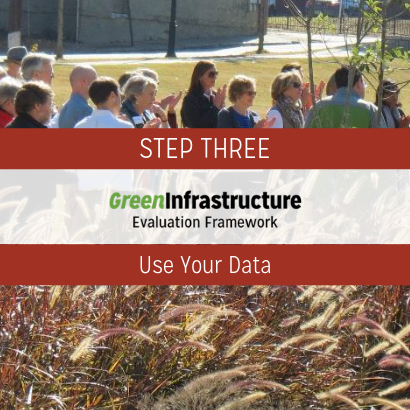• Manage data to ensure easy analysis;
• Analyze that data with an eye towards pulling out trends, weaknesses and bright spots; and,
• Create a culture of continuous improvement around GI, so you can boost the knowledge and skills of your organization, and deliver even better GI projects in the future.
Use these tips and resources to plan ahead so that when you do collect data, you are prepared to analyze and use it immediately.
Tips for GI Data Management and Analysis
This Framework does not delve deeply into the technicalities of data analysis across environmental and other benefit areas. NRPA focuses instead on key tips for drawing insights from your data, regardless of the size, scope or other details of your project.
Tip #1: Create a simple data "home base" within your organization’s online file system:
• Before you start collecting data, create a data home-base for the information you collect. Staying organized from the beginning will allow you to spend less time managing the information and more time using it.
• Create a straightforward file system. For example, set up one folder for each of the four benefits covered in this Framework (environmental, health, social and economic).
• In this hub, you will have:
- All data collection instruments based on your measurement plan (e.g., survey instruments, SOPARC docs, Citizen Science guides for volunteers, etc.).
- All the data that you collect (e.g., completed paper surveys, e-survey exported data, completed SOPARC records, downloaded Citizen Science data).
Tip #2: Create a Microsoft Excel database for managing and analyzing your data:
• Data management can seem overwhelming, but for your purposes, Excel (or any similar product like Google Docs) should be sufficient.
• Create one tab for each kind of benefits data: environmental, health, social, economic.
• Put pre- and post-construction data within each benefit tab for easier analysis.
• Enter data into the database as soon as you collect it.
Tip #3: Base your conclusions and decision making on data trends, not outliers:
• Be careful when one or two pieces of data, positive or negative, do not fit the larger picture painted by your whole body of evidence. Human nature urges us to respond to an outlier, but sound conclusions are based on a lot of data pointing in the same direction.
• For example, you may receive one or two survey comments that your GI feature did not encourage physical activity in the community. But if the remaining 96 percent of respondents claim that it did, and other data sources support that view (SOPARC or accelerometer data), you can safely draw a conclusion that your project had a positive effect in this area.
• The respondent’s outlier perceptions may still be useful, but they should not affect your conclusions about the project’s impact.
Tip #4: Take steps to maintain data quality, but also make the data easily accessible:
• Send an email to all parties involved in your project about data management and analysis,
• Appoint one or two staff as data “gatekeepers” so that you limit the number of people uploading and updating information.
• Make your data available to all stakeholders, to keep everyone interested in all the information that you are collecting on your project’s impact.

